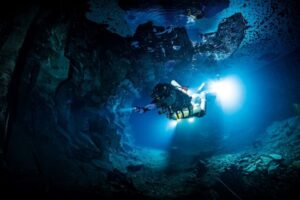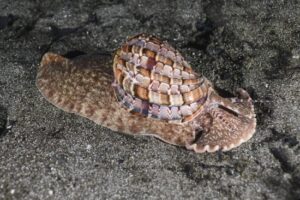With more than 1,500 km of coastline and around 600 islands, hosting everything from subtropical islands to dramatic fiords, New Zealand is a dive destination like no other. You are never far from the ocean in this incredible country and the diving is outstanding – yet few people know about it. Read on to discover some of the top-rated dives in New Zealand and get inspired to visit as New Zealand’s borders continue to open.
Rainbow Warrior, Cavalli Islands.
Just 10 minutes by boat from Matauri Bay in Northland, lies the Greenpeace flagship Rainbow Warrior. This famous vessel is one of the most popular dive sites in New Zealand and is a vibrant artificial reef, covered in pink and orange jewel anemones and surrounded by demoiselles and blue maomao.
This stunning wreck sits at around 26 meters deep in mild currents, making it an excellent wreck for advanced divers. Close to the top of New Zealand, it is also the ideal spot to start your New Zealand diving adventure.
HMNZS Canterbury, Bay of Islands.
The nearby HMNZS Canterbury is another one of New Zealand’s best-known wrecks and was scuttled in 2007 to become an artificial reef in Deep Water Cove. Sitting at 32 to 36 meters in a no-take zone, this wreck has become a flourishing ecosystem.
This is an impressive wreck, upright and intact, and in great condition. She is home to large schools of fish, including kingfish and snapper, there are crayfish hiding in the interior, and the exterior is covered in eye-catching anemones.
Cape Brett Peninsula, Bay of Islands.
Whilst the HMNZS Canterbury is the most sought-after dive around the Cape Brett Peninsula, there is plenty more to see in this fascinating area. The reefs of Deep Water Cove are stunning, having been a marine reserve since 2010, and are full of life. There are healthy kelp beds, sponges and numerous fish species in these sheltered, calm waters.
Around the peninsula, there are also boulder landscapes, an impressive swim-through and 35-meter-long tunnel, shallow fish nurseries, and occasional seals basking on the rocks.
Cathedral Cave, Piercy Island.
One of Northland’s most famous dive sites, Cathedral Cave, sits just off the northern tip of Cape Brett. This jaw-dropping sea cave has huge resident stingrays and bright blue waters lit from overhead. It is a great place to spot reef fish, nudibranchs and moray eels.
There is a current-washed wall outside the cave that attracts pelagics to the area. Tech divers who venture down the wall and into the 70-meter range are sometimes rewarded with sightings of bronze whaler sharks.
Poor Knights Islands, Tutukaka.
If you only go diving in New Zealand in one place, make it the Poor Knights Islands. These world-famous islands in Northland offer an exciting mix of subtropical diving with temperate New Zealand species as well. This special dive spot was rated as one of the world’s best by Jacques Cousteau.
There are numerous dive sites to choose from at the Poor Knights and the waters host an incredible density of fish. The underwater landscapes are covered in encrusting life and there are hundreds of mating stingrays to encounter during summer. Manta rays, sea turtles and even orcas visit at that time of year.
That said, diving the Poor Knights in winter is just as rewarding, with cool green waters and swaying kelp forests to explore. These unrivalled islands are a must for any scuba diver visiting New Zealand, and they are perfect for snorkelers as well.
Great Barrier Island, Auckland.
Further south and close to Auckland, Great Barrier Island and its neighbor Little Barrier Island offers the chance to spot hammerhead sharks. Hundreds of hammerhead sharks have been seen there in the summer months, from December to March.
But even if you don’t see hammerheads, Little Barrier Island boasts a shallow reef with several swim-throughs and a small arch. There are trevally, kingfish and abundant reef fish to encounter at these beautiful islands.
If you have time whilst you’re visiting Auckland, take a detour to Goat Island at Leigh. This was New Zealand’s first marine reserve and is a rich marine ecosystem with excellent diving and snorkeling.
The Auckland area is also one of the best places to become an Open Water Diver. There are dozens of dive sites close to shore and a handful of excellent dive centers. Auckland also has easy access to the rest of New Zealand’s top dive destinations.
The Mercury Islands, Coromandel.
Sitting on the east coast of the North Island, the Coromandel Peninsula is dotted with islands and soft, white sands that attract tourists every year. There are spectacular underwater landscapes there, including caves, pinnacles, walls and drop-offs.
The Mercury Islands have dive sites for all experience levels and host numerous fish species in the shallows and at depth. The islands also host an array of seasonal visitors, including whales, bronze whaler sharks, makos, stingrays, marlin, and other subtropical species.
This is a great dive spot if you hope to encounter marine life large and small, then spend your non-diving days lazing on glorious beaches.
The Aldermen Islands, Coromandel.
The nearby Aldermen Islands’ underwater scenery rivals that of the Poor Knights Islands and includes deep walls, honeycomb-like caves, grassy beds, kelp forests and striking pinnacles.
This is a great dive spot for experienced divers, with deep walls dropping to over 35 meters. There are also some shallower dive sites to enjoy. The fish life at these islands is remarkable, with countless blue maomao, mackerel, schooling kingfish and abundant smaller reef fish.
Lake Taupo, Waikato.
Lake Taupo is unlikely to be the first place you think about for diving in New Zealand, but don’t let that deter you. If you are visiting this vast and impressive lake, take some time to explore underwater.
There are cliff faces and rocky structures that host freshwater crayfish, rainbow and brown trout, and smaller bottom-dwelling fish. With easy access and BBQ facilities at the shoreline, Lake Taupo is a fun dive spot during the kiwi summer.
Alternatively, why not visit during winter? You can go diving with snow-capped Mount Ruapehu in the background and take a trip to the nearby geothermal hot pools afterwards.
Taputeranga Marine Reserve, Wellington.
One of the best things about New Zealand is that you can dive in the middle of nowhere or right next to New Zealand’s gorgeous cities. Wellington, the small but mighty capital of New Zealand, is a great place for a weekend of diving, chocolate tasting, craft beer, and coffee culture.
Wellington’s rugged coastline and protected harbors host a wealth of life, meaning there is somewhere to go diving no matter the weather. The Taputeranga Marine Reserve is one of the most popular dive spots around Wellington and is a must for families. It has an excellent snorkeling trail and easy shore dives among anemone-covered rocks and kelp beds. Look closely for octopi and conger eels and don’t be surprised if you are followed around by the friendly blue cod.
MV Mikhail Lermontov, Marlborough Sounds.
The MV Mikhail Lermontov is an impressive sight indeed. This huge former cruise ship is 155 meters long and sank after hitting rocks in the Marlborough Sounds in 1986. She is one of the largest modern diving wrecks and many of the original furnishings are still present.
This isn’t the easiest wreck to get to, but the rewards are well worth it. She is tucked away in the idyllic Marlborough Sounds, where the water is almost always calm and inviting. The wreck lies at 37 meters deep, but most diving is done at 15 – 35 meters.
When you’ve finished exploring this magnificent wreck, take a day trip to Picton to go swimming with dolphins or explore the dives sites of the Queen Charlotte Sound.
Milford Sound, Fiordland.
Last but by no means least, the very bottom of New Zealand has some bracing but unmissable dives. With the right exposure suit and a sense of adventure, you are ready for some of New Zealand’s most unique diving.
Fiordland National Park is part of a UNESCO World Heritage Site known for its glacier-carved valleys and ancient rainforests. Whilst most people visit to experience the landscapes of this enviable wilderness area, the diving is also excellent.
Because of the high rainfall and tannin-stained runoff in Fiordland, there is a layer of dark freshwater on the surface of these moody-looking fiords. This has allowed light-sensitive species, normally only found at much greater depths, to flourish in the shallows.
Milford Sound is the most accessible place to go diving in Fiordland and has dramatic cliffs that plunge into the dark waters. There are numerous black corals in the shallows, plus red corals, crayfish, diverse fish life, eagle rays, stingrays, and – occasionally – passing great white sharks.
At the end of your dive, you will surface among the most magical scenery imaginable. It is a world of ancient trees, tumbling waterfalls, and the iconic Mitre Peak.
This is New Zealand at its finest.
What experience do you need to go diving in New Zealand?
There are dive sites suitable for all experience levels in New Zealand.
If you are a beginner, try diving around Auckland or Leigh, or head to the Bay of Islands.
If you like an adventure off the beaten path, go diving in Fiordland or plan a weekend trip to dive the MV Mikhail Lermontov
When is the best time to go diving in New Zealand?
There is excellent scuba diving in New Zealand year-round, though December to March is the best time for warmer waters and subtropical marine life.
Kathryn Curzon, a shark conservationist and dive travel writer for SSI (Scuba Schools International), wrote this article.
The post 12 Great Places to go Diving in New Zealand appeared first on Mares – Scuba Diving Blog.
Read MoreDiving, dive locations, dive spots, New Zealand, SSIMares – Scuba Diving Blog



